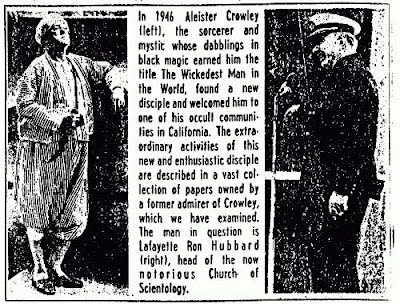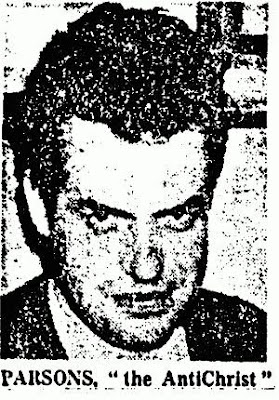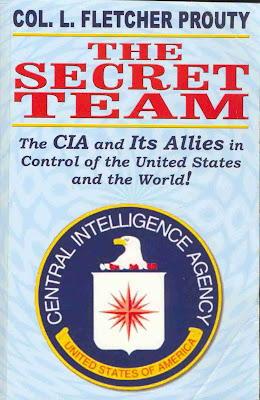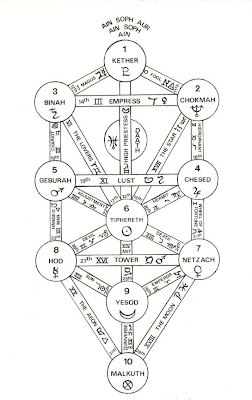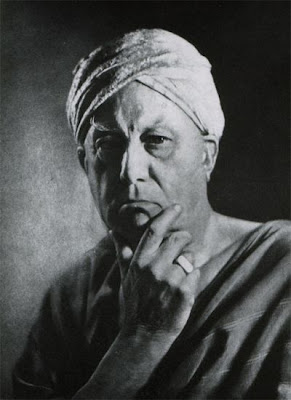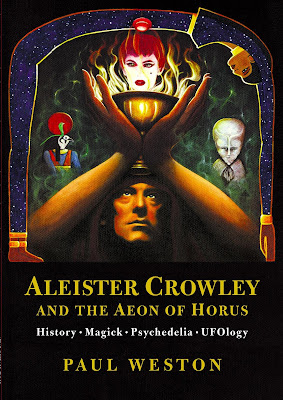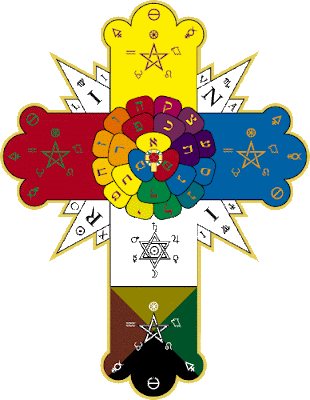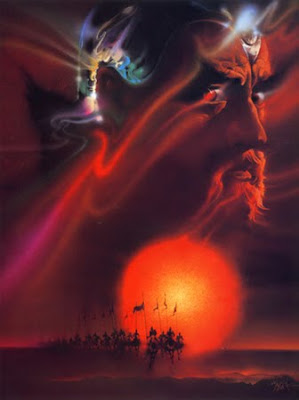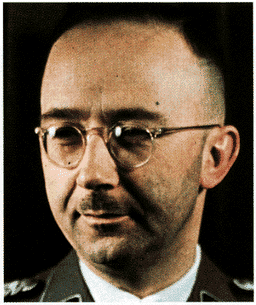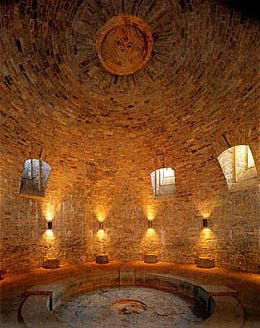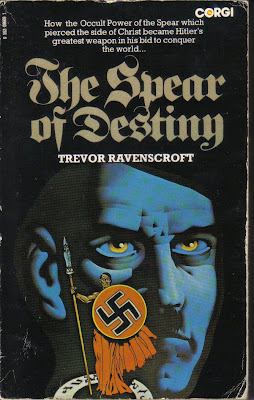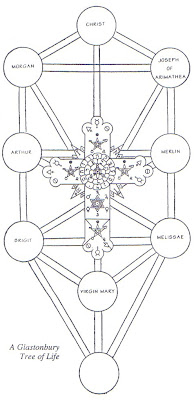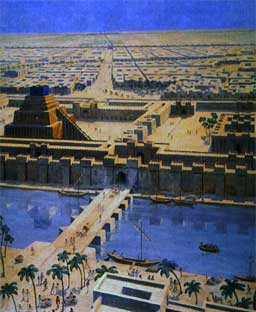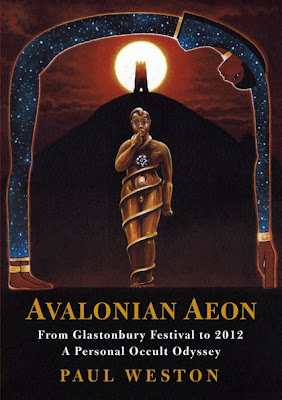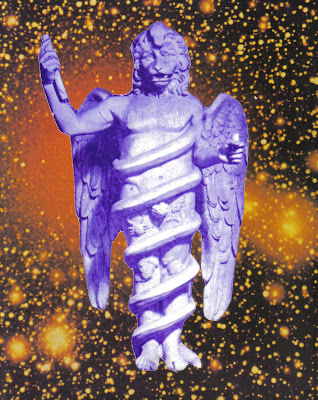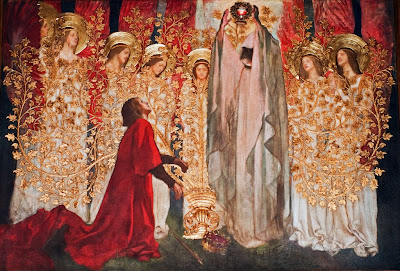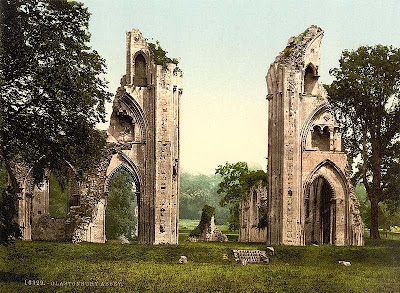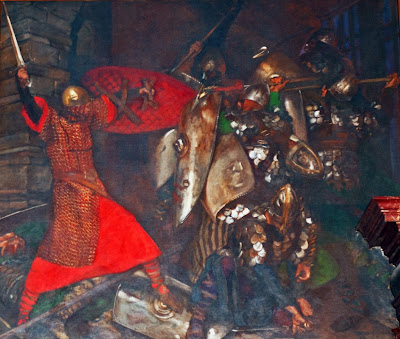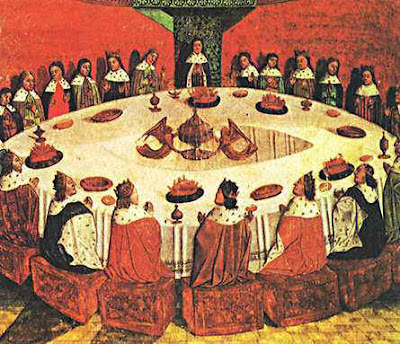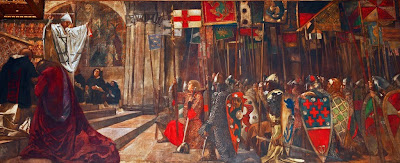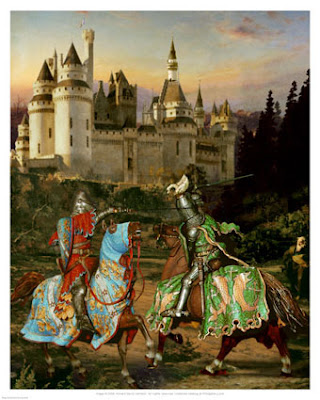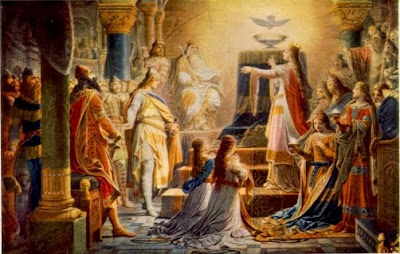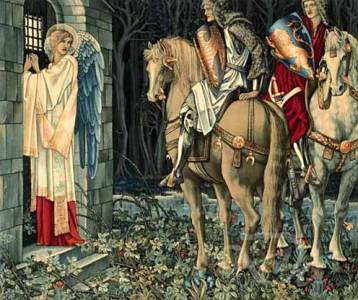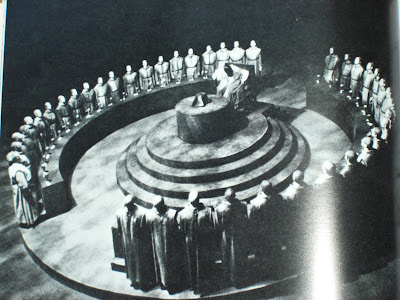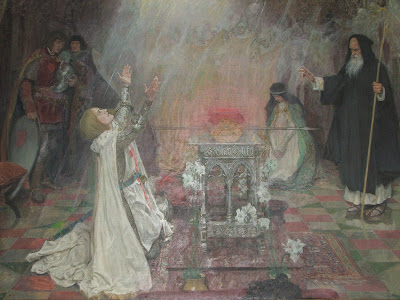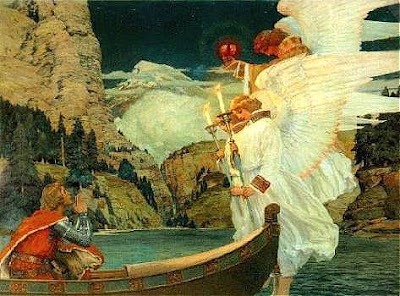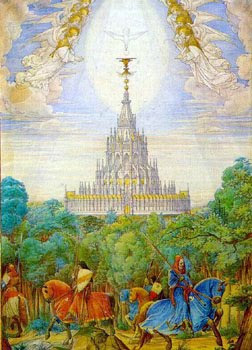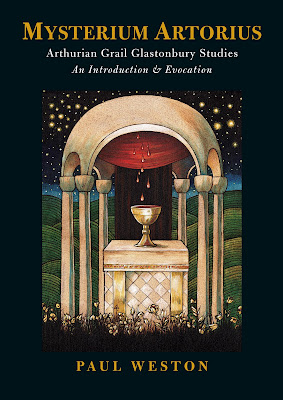![]() "Sir Galahad is now King of Sarras, and upon a hill he makes a Sacred Place and builds a Golden Tree."
"Sir Galahad is now King of Sarras, and upon a hill he makes a Sacred Place and builds a Golden Tree." Edwin Austin Abbey. One of a numinous sequence of 15 murals painted in Boston Public Library that will feature throughout this article.
Here is a significantly expanded version of a piece on the Grail Romance
Perlesvaus that has appeared in slightly variant forms in two of my books,
Avalonian Aeon, and
Mysterium Artorius. It should eventually be published in a projected anthology of work by various Glastonbury based Katharine Maltwood and terrestrial zodiac enthusiasts. As well as hoping to interest the reader in the bizarre medieval tale, I also seek to acknowledge Hank Harrison, who has been immersed in the mystery for a lot longer than I have and whose stimulating work has been unjustly neglected. Quotations are taken from the Sebastian Evans translation, an edition known to polarise opinions but one for which I have considerable affection. This is a long piece so I have included a number of images that are hopefully conducive to its pleasent digestion.
Katherine Maltwood’s presentation of her Glastonbury Zodiac work is comprehensively rooted in the medieval Grail Romance
Perlesvaus, more generally known as the
High History of the Holy Grail. The text therefore represents fundamental source material that needs to be examined in order to assess the veracity of the terrestrial zodiac concept.
![]()
At the end of the story it’s stated that,
‘the Latin from whence this History was drawn into Romance, was taken in the Isle of Avalon, in a holy house of religion that standeth at the head of the Moors Adventurous, there where King Arthur and Queen Guenevere lie’. This is an obvious reference to Glastonbury Abbey and implies that those words at least must have been written following the alleged discovery of Arthur’s grave in 1190/91. It could be, however, that with the story being so well-known, Glastonbury was invoked in the way that Geoffrey of Monmouth in his
History of the Kings of Britain talked of ancient documents he had used, or Wolfram von Eschenbach in
Parzival boasted of esoteric sources in Spain. They may be stylistic devices to gain credibility.
![]()
![]()
Written in French by an unknown author,
Perlesvaus takes up the general Grail story where Chretien de Troyes left off. His
Conte del Graal has generally been considered as the earliest telling of the tale. A number of “continuations” sprang from his work. Characters, motifs, and plot details in Perlesvaus refer back to de Troyes and a few other early Grail Romances. The author demonstrates wide reading and knowledge of the existing literature.
![]()
Some critics believe that the text was written in the decade 1200-1210. A date as late as 1250 has also been suggested. Therefore it is difficult to determine whether it comes before or after the important works of Robert de Borron and the Queste Del Saint Graal, and what its level of originality may be. Which work first mentions certain themes may perhaps only be of interest to scholars.
When it comes to potential sites for the narrative, a landmark quite likely to be Glastonbury Tor is described, but so are features of Tintagel, which is clearly mentioned as a location. Some have found details suggestive of Pembrokeshire, possibly taken from the
Descriptio Cambriae of Giraldus Cambrensis, written about 1188. One theory bases the author on the borders of Wales and Shropshire. Another hints that he may have been a monk in the Priory of Bassaleg near Newport, founded in 1110 by Robert de Haga and his wife Gudreda as a cell to Glastonbury. There are many allusions to Wales and Welsh customs in the story. All distances except one are measured in Welsh leagues. Two Welsh knights who become hermits are the last to find the Grail castle. Hermits remained common in Wales later than the England of the Norman Conquest. There’s also a case to be made for the author coming from what today would be Belgium. An early copy was in the possession of the Lord of Cambrin in Flanders.
Whoever did write it, and wherever they were based, they clearly had access to Welsh Celtic mythological material. Perlesvaus is permeated by it, perhaps more extensively than any other Grail Romance. Despite that, it’s also more militantly and crusadingly Christian than the other works of the time. Arabs are brutally killed with great relish, as are pagans and any other resistors of the new law of Christ.
Regardless of the issues over the dating of the text, there are a number of significant elements in the story that are unique. The Grail changes form. It is clearly stated that it has five aspects, each manifesting amidst the usual light and fragrance. These are: crowned king crucified; child; A man wearing a crown of thorns, bleeding from the forehead, palms, feet and side; The fourth form is unspecified; the fifth is a chalice.
![]()
The Fisher King actually dies, a detail at odds with the standard version of the Grail story, where his healing is of paramount importance. Also, following the usual narrative, Perceval failed to ask the correct question when being in the presence of a strange Grail feast but rectifies this later. In Perlesvaus however, this is accomplished not by getting a second chance to ask the proper question but by taking the Grail castle by force of arms. Arthur and Guenevere have a son named Lohot. Their union is usually portrayed as childless. Lohot is murdered, and in another unique development, Guenevere subsequently dies of grief.
Alongside Perceval, Gawain and Lancelot feature as major characters of the Quest. Arthur is also involved and can be seen as making up a fourfold grouping of heroes, but his adventures are proportionately less than the other three who move through a recurring landscape of castles, chapels, forests and meadows, meeting a bewildering sequence of maidens, hermits, knights, kings, deceitful dwarves and the occasional demonic giant.
![]()
A number of obvious themes and motifs recur throughout the story. The name Perlesvaus itself is explained as meaning essentially, Perceval the disinherited. Rightfully-held land is repeatedly stolen and heroically regained throughout the story by a number of characters. There are complex webs of family relationships and blood feuds. Instances of withheld and mistaken identity constantly move the plot along. The central character, Perceval himself, changes his shield and apparel, going unrecognised in the close company of members of his own family, such as his sister, his uncle, the Fisher King, and knights he has previously met, Gawain and Lancelot. Perceval often mysteriously refrains from identifying himself in these situations. Characters ask the names of others and are sometimes refused the information. Quite why this is never gets explained.
![]()
To modern sensibilities, it is an extremely odd story. According to the great Arthurian scholar Roger Sherman Loomis,
‘the author seems at times deranged,’ demonstrating
‘savage vindictiveness’ and ‘a taste for the gruesome.’ Norma Lorre Goodrich went even further, referring to him as
‘a psychopath like the filthy Marquis de Sade’. Nonetheless, both these authors and other critics have praised the imagination and skill therein.
![]()
The strangeness is apparent quite early on in the narrative. Arthur has been languishing in Fisher King manner. The land has suffered, his knights departed and great deeds been neglected. He manages to recover and convenes a great gathering at Cardueil on the feast of St John, which is at midsummer. Gawain and Lancelot are unable to appear, but five hundred knights attend in a vivid scene.
‘The sun shone through the windows everywhere amidst the hall that was strown of flowers and rushes and sweet herbs and gave out smell like as had it been sprinkled of balm.’After the meal has begun, an extraordinary procession arrives. Three maidens enter the hall. The first rides on a white mule that wears a headpiece of gold, an ivory saddle inlaid with jewels, and a saddle-cloth of red samite traced with gold. The maiden sports a silken gown and a head-dress
‘loaded of costly stones that flamed like fire.’ This funky hat hides the fact that she’s bald. Her right arm is hung in a sling and both arms rest on a fabulously rich cushion adorned with golden bells. With both hands, she holds the head of a king, sealed in silver and crowned in gold.
![]() For some reason, I tend to picture the bald maiden as resembling the Borg Queen.
For some reason, I tend to picture the bald maiden as resembling the Borg Queen.The second maiden rides in
‘after the fashion of a squire’. A wooden box is tied behind her that a hunting-dog sits upon. Around her neck, a shield is hung. It has a design of argent and azure bands with a red cross and gold boss. The third maiden is described as the most beautiful of the group. She walks in, wearing a short skirt and carrying a whip!
![]() Maybe Keira might have made a more credible Maiden of the Cart than a Guenevere?
Maybe Keira might have made a more credible Maiden of the Cart than a Guenevere?The bald leader cannot dismount in the company of knights until the Grail is attained. She explains to Arthur that the shield belonged to Joseph of Arimathea. Arthur is requested to hang it on a pillar in the middle of the hall until a pre-ordained knight retrieves it. With the shield, he will gain the Grail and then return with another shield emblazoned with a white stag on a red background. The hunting-dog is also to remain and will respond to no-one until the knight arrives.
She goes on to bring greetings from the Fisher King and laments his malaise. It is attributed to the failure of a knight to ask the right question about the Grail. This is where the tale follows on from de Troyes. Arthur’s own earlier inertia was a part of the greater sickness that sprang from this event. The maiden removes her hat, displaying her baldness. She had once sported beautiful hair but the knight’s failure has caused its loss. The baldness will remain until the Grail situation is rectified.
![]()
![]()
Arthur’s attention is then drawn to a cart that the maidens have left outside the hall. It is harnessed to three white stags. The vehicle is draped in black samite with a long gold cross atop it. Beneath the drape is a macabre load of 150 severed heads, sealed variously in gold, silver, and lead. The kind of person who keeps count of things such as how many times goats appear in the Bible might like to add-up the severed head count in Perlesvaus. The notable Celtic motif makes regular appearances. All of this spectacular horror is down to the knight’s failure. It is further revealed that the maiden with the shield is also carrying a queen’s head sealed in lead and crowned with copper. She had betrayed the king whose head the bald maiden carried, and the 150 knights of the cart.
The requests are granted. The shield is hung upon a pillar and the dog looked after. The strange maidens depart with their stag-led cart full of heads. Arthur, Guenevere, and all of the feasting knights watch in wonder, noting again that the lady on foot in the short skirt carrying a whip was indeed the most bodacious. The macabre group journey on and soon encounter Gawain. He is entreated to go to the Fisher King and thereby remedy the calamitous situation. Help is also needed to successfully pass an upcoming perilous castle. Gawain is more concerned about the babe with the whip. He wants to know why she’s walking and not riding on the cart. It is explained to him that it’s part of a penance resulting from the failed-question disaster. If he goes and sorts it all out, she’ll be okay and the bald maiden will grow hair. Gawain is inspired to take up the challenge.
The group soon
‘enter into the most hideous forest and most horrible that any might ever see.’ Trees are bare-branched, black and burnt. The ground is parched and full of cracks. Eventually, in a great valley, they come upon a black castle enclosed by a circular wall,
‘foul and evil seeming.’ The nearer they get, the more the bad vibe increases.
‘Great halls appear that were right foully mis-shapen.’ From a black mountain behind the castle, a river descends with a thunderous roaring. A further blasted forest looms beyond. The gateway to the castle suggests the mouth of hell; from it can be heard
‘great outcries and lamentations.’ Many people are waiting for the arrival of a good knight. The bald maiden explains to Gawain that they have arrived at the castle of the Black Hermit and she advises him not to get involved but it is too late. From the castle gates, 152 knights, clad in black and riding black horses, come riding out. They each take one of the severed heads, spike them on the end of their lances and gallop back in, rejoicing. Bummer. Gawain comments, ‘
Damsel, an evil castle is this where folk are robbed on such wise.’ Only the arrival of the fabled good knight can rectify the crime.
![]()
They prepare to leave the environs of the castle, but the action’s not over yet. A lone knight appears and tells Gawain that he must joust with him for the shield he carries, which had belonged to the Jewish Old Testament hero Judas Machabeus. Gawain is victorious and the shield is given over to the maidens who point out to him the path he must follow, into a beautiful forest. He takes his leave of them, but not before a further riddle. The whip-maiden calls after Gawain to make him aware that he had failed to ask the bald maiden why her arm is in a sling, resting on a cushion. She warns him to be more alert at the court of the Fisher King. The bald maiden further points out that none of the earlier assembled feast, including Arthur himself, had asked her. She’s not going to tell anyway. Only the most cowardly knight in the world knows the answer. He’s in her service and looking for her, but can’t find her. With that, they part company.
![]()
I’m not going to go through the whole
Perlesvaus story in such detail. The maidens and the cart episode is enough to indicate the weirdness of the tale. What on earth is it all about? A few things do become a little clearer later on in the text. Gawain passes through the Castle of Enquiry. An obliging priest there gives him a few pointers. The Black Hermit is none other than Lucifer, ruling over hell as he had wanted to do in Paradise. As for the cart full of severed heads, the ones sealed in gold signify the new law of Christianity; in silver, the old law of the Jews; and in lead, the false law of the Saracen Muslims. The male and female heads held by the maidens are Adam and Eve. The bald maiden signifies Fortune, who was bald before the crucifixion but grew hair after the blood of the saviour redeemed the world.
That’s only a few things. The narrative seems preposterously allusive. Every image and detail could carry layers of meaning. Did the author have a grand scheme? Is it all carefully placed in the manner of a James Joyce? It doesn’t necessarily follow. And that’s only the start of quite a long story.
After he left the maidens of the cart, Gawain encounters the Fisher King and is set a task before he can enter his castle and see the Grail. He has to recover the sword that beheaded John the Baptist from a pagan king. If the sword is drawn from its sheath at midday, it is covered in blood. It seems that a sword presented to Perceval at the start of the Grail feast in de Troyes’ tale is being deliberately identified as the beheader of the Baptist. Adding this detail to the story’s stated beginning on the midsummer feast of John, and the preponderance of the severed head motif perhaps indicates the presence of Johannite heresies. This is but one of a spectacular series of holy relics that make an appearance in
Perlesvaus.![]()
![]()
![]()
In the Grail castle, the usual procession appears and a feast begins. Here the uniquely mutable Grail makes appearances. Gawain has three sightings of it. The first occurs when two damsels appear with the cup and lance, which is allowed to bleed into it.
‘Gawain gazes at the Grail and it seems to him that there is a chalice within it, albeit there was none at the time.’ The next time he,
‘seemed to behold in the midst of the Grail the form of a child’. In the final appearance, Gawain sees the crucified Christ, pierced by a spear. He is so awe-struck by these visions that he neglects to ask the right questions, thereby failing the Quest. The scene has many similarities to de Troyes’ depictions of Perceval’s failure, but also some interesting differences. The Fisher King is absent from the hall during the feast. Angels rather than squires bear the candelabra. The Grail hovers in the air at one point. There are twelve knights present, who are all over a hundred years old, although they don’t look it.
![]()
![]()
After Gawain’s failure, the quest is taken up by Lancelot. In support of the idea that the Grail heroes are all interchangeable solar figures, the four main characters can easily be seen to embody seasonal qualities. Arthur is winter. The kingdom is inert. The quest begins with Gawain, the Hawk of May. Lancelot, very much the summer sun, gets to the Grail castle and meets the Fisher King, but is not granted a sighting of the holy artefact due to his sinful love for Guenevere. He then gives over the quest to Perceval who slays some golden-bull worshippers and consequently gets his own invitation for a look at the Grail. It’s seen with the Baptist’s sword, a bell of Solomon and a whole heap of other relics.
![]() Guenevere and Lancelot from Excalibur.
Guenevere and Lancelot from Excalibur. Perceval later encounters some strange behaviour from two priests by a red cross in a forest. One ecstatically kisses it. The second beats the cross with a stick and
‘weepeth right passing sore’. Perceval asks what’s going on and is told it’s none of his business. There’s more than a waft of heresy in the bizarre scene. Cathars, Templars, Gnostic dualism, kinky sex? Take your pick.
There are a number of bizarre and grotesque set-pieces. When Perceval defeats the Lord of the Fens, who had stolen his mother’s land, he has eleven of the Lord’s men beheaded and their blood drained into a vat into which their leader is then lowered head first and left to drown. At one point, two artificial men, who were created by sorcery wield giant hammers and beat out the brains of nearly fifteen hundred people. In an ongoing vigorous round of combat, jousting with lances and swordplay on foot is portrayed in grim detail as armour is ripped and rendered, limbs and heads are hacked off, and horses collide and crash to the ground. Maidens, innocent and otherwise, are whipped, beaten, and killed as blood flows and piteous lamentations fill the air. As a reader of most of the classic Romances of the time, it appears to me that Perlesvaus is the one containing the most detailed and sustained violence and it’s easy to understand the opinions of Loomis and Goodrich.
A modern reader might also note that, although there are some fascinating snippets about the Grail, its five changes and so on, it doesn’t really seem to be that important to the story. A lot of the other themes appear to be far more predominant.
What have the critics made of the form of the story as a whole? The bald maiden is a good starting point. In his epochal epic
The Golden Bough ,JG Frazer collected together vast amounts of data from the world’s religious history and folklore. He came to feel that much of it demonstrated a fundamental belief that the king and the land are one. The vegetation deity lives within him, so the monarch’s vitality is linked to the fertility of the earth. When he is healthy, the crops thrive, when he declines; the land does with him. As a result, he may have to be ritually killed by a healthy successor.
Something about all this reminded Arthurian scholar Jessie Weston of the recurring theme of the wasteland in the Grail tales. The Fisher King seems to be a Frazerian monarch in decline. His mysterious wounding through the thighs is often taken as a euphemism for impotence. The whole kingdom suffers with him. In
From Ritual to Romance, published in 1920, she argued that Romance literature derived from myth. Since Frazer believed that myth derived from ritual, Romance literature could have some kind of foundation in ancient ritual.
Using Frazer as her inspiration, whilst not ignoring the Celtic sources, Weston also sought additional roots far more widely, coming to the inspiring hypothesis that there may have been a direct continuity linking ancient fertility rites with the Grail Romances. Something of the classical mystery cults, where dying and resurrected deities were celebrated, may have lingered. She mentioned that the female devotees of Adonis shaved their heads following his demise. John Cowper Powys, influenced by Weston’s thinking, featured a bald female Grail messenger as the character of Mad Bet Chinnock in
A Glastonbury Romance.![]()
The bald maiden also seems to correspond to a character in de Troyes known as the loathly damsel, although in
Perlesvaus she is not depicted as being ugly and with some animal features, as she is in the earlier work. Loomis believes she derives from the Celtic figure of sovereignty, not unlike Eriu the personification of Ireland. When Gawain first meets her, she advises him on the question to ask at the Grail castle. He later learns she was the Grail bearer. The cart is stated to be the Wheel of Fortune, although unlike any known depiction of it. A cart pulled by stags appears in Irish mythology as vehicle of the mermaid Liban, daughter of the god Dagda. After Perceval gains the Grail, he meets the maiden, whose hair has been restored. Some of the heads are retrieved for her. By then, she seems to also symbolise the Church. The author of
Perlesvaus has drawn together a number of disparate elements to create the bald maiden. The process whereby a pagan goddess ends up personifying the Church seems a bit convoluted and incoherent. There may not have been any esoteric subtlety in his awkward blend.
A case has been made by Professor J. Neale Carman for a complex system of allusions throughout the text, whereby many characters and events parallel the story of Christ, both scriptural and apocryphal. Perceval’s original failure to ask the right question, with its catastrophic results, is like the fall from Eden. His conquest of the Grail Castle represents the crucifixion. He is carrying a red-cross shield which has already been referred to as ‘
the holy shield of the Cross for which none but God ever dared pay the price.’ A group of watching hermits correspond to the disciples. There’s a huge amount of such episodes and their style is such that they’re not systematic. Gawain has adventures that call to mind both John the Baptist and St Peter. Perceval is quite messianic and Christ-like but when the Fisher King can serve a similar allegorical purpose, he does. The Fisher King’s death is announced to Perceval’s sister Dindrane in the Perilous Cemetery. It’s dark like the climax of the crucifixion. There’s an earthquake. An altar cloth is torn like the temple veil. Dindrane seems to stand for the Virgin Mary. And so on.
A good example of this general allegorical approach concerns the questing beast, equated with the so-called girt dog of Langport by Maltwood and Caine. In Perlesvaus, she’s small, white, and pregnant with twelve barking hounds. When she gives birth to them by a cross, they tear her to pieces but aren’t able to consume the flesh. According to the bizarre allegorical scheme of the medieval author, the beast represents Jesus and the hounds are the Jews who crucified him but weren’t able to ingest the sacrament of his body. Roger Sherman Loomis commented on this episode that,
‘To select a pregnant bitch to signify the incarnate Deity seems the last word in extravagance and bad taste.’![]()
After Gawain’s failure, the quest is taken up by Lancelot and finally, Perceval. The Grail Castle actually gets captured by the bad guys but Perceval single-handedly sorts out this little problem barely halfway through the story. Before he does so, there is an enigmatic brief moment when his presence is sufficient to ensure the long prophesied opening of a tomb that turns out to contain his ancestor, Joseph of Arimathea. Not a lot is made of this potentially momentous event and it’s interesting that no Glastonbury connection of any kind is made. With the Grail castle secure and Perceval’s family honour upheld, a second narrative dynamic leads up to a finale where he finally takes on a major villain, the Black Hermit, who is in fact none other than Lucifer, the Lord of Hell.
![]()
It has been suggested that the action deliberately models the
Book of Revelation. During the crusading days, it was constantly being invoked. The city of Jerusalem loomed large in the collective mind, having been recently reclaimed for Christendom during the first crusade. In 1187, the legendary Saladin had regained it for Islam. This stimulated the third crusade in which Richard the Lion Heart famously participated. These huge events seemed very much to be the drama of the End-Times, being played out close to the time generally accepted for the writing of
Perlesvaus. The Holy Land and Camelot become an interchangeable landscape, as at one point in the story some of Arthur’s kingdom is taken by the forces of Islam.
The overcoming of the Black Hermit in
Perlesvaus seems very brief and underplayed for the dramatic climax of the book. Perceval unhorses and wounds him. He is not actually killed. His followers seize him, uncover a huge pit and fling him in. This happens to Satan in
Revelation. Perceval retrieves the heads sealed in gold, the Christians. The Jewish and Muslim heads have been put permanently out of reach by the Black Hermit. This is only a hint of the amount of details that seem to mirror the Bible story.
The mysterious author’s anonymity has been cited as an indication that he may have been a member of a military order. There are so many details given in the course of the story, involving armour, weapons and grisly descriptions of wounds, that it seems possible he had been on a real battlefield. The Teutonic Knights are known to have encouraged anonymous poets in their order. Perhaps he was a Templar. They don’t get a specific name-check but their presence in the story seems fairly clear. Perceval enters a castle containing 33 initiates wearing white garments with red crosses. Their master claims to have seen the Grail.
![]()
It may well be that readers familiar with the Maltwood/Caine corpus have recognised very little in the preceding account of
Perlesvaus and that is important. There are a number of big events in the story that they don’t cover. The fifteen hundred people getting their brains bashed out with giant hammers and the drowning in a vat of blood and suchlike don’t feature much in the zodiacal exegesis. How do the biblical allusions mesh together with the supposed local landscape references? Hostile critics can be forgiven their scepticism.
One maverick critic has given considerable time and ingenuity to the enigma of Perlesvaus. Hank Harrison is probably best known as the father of rock and movie star Courtney Love. Far more interesting to me is his decades-long interest in the Grail and all matters pertaining thereto. He studied at the Warburg Institute with the legendary Frances Yates. In his major published work,
The Cauldron and the Grail, Harrison postulated continuity from megalithic times to the Gothic cathedral builders via such themes as the light beam orientation through the long barrows and cathedrals into the primal womb of the Goddess, with the mystery served from vessels that evolved from skull cups to Grail chalices.
Harrison has also produced a number of essays about
Perlesvaus, the mystery of its authorship and the nature of its meaning. Their content is contentious and provocative, unlikely to convince academics. Although I am far from comfortable with a lot of his details, I get the feeling from his work of that certain something that does lead into the true temple of the mysteries being conveyed. One statement by him is worth remembering whilst entering into the historical material he has assembled.
‘The Grail is not an object, but rather an initiation, a ceremony, which transforms the supplicant from simple soul to brilliant mind.’![]()
Harrison believes that the fabled source material for the Grail Romances mentioned by a number of authors from de Troyes onwards really did exist and was in fact the Perlesvaus. He goes further still by contending that it was written by Henry of Blois who in turn was making use of an even earlier text.
![]() Henry of Blois
Henry of BloisIn order to get a feeling for whether this man might have been the author, we need to get a sense of who he was. Henry of Blois, a nephew of King Henry I, was asked by his uncle in 1126 to become Abbot of Glastonbury Abbey whilst still in his twenties. An ancestor of Henry known as Theobald the Cheat captured the area in France around Blois and the county of Chartres in the tenth century. From then on, the family was very much in the centre of some major early medieval esoteric action. The town of Blois is situated in the vicinity of Troyes, home to Grail author de Troyes, and a Templar power base. Henry was considered to be an academic prodigy. The learning and philosophy behind the new Gothic style of architecture then developing would have been part of the general mindset he brought to his new appointment at Glastonbury.
With the special permission of the Pope, Henry also uniquely took on the simultaneous role of Bishop of Winchester, then the main royal city in England. The royal mint was located there, along with the great Domesday Book survey. He initiated huge building programs: both ecclesiastical, at Glastonbury and Winchester, and secular, erecting a host of castles around the country. Glastonbury was soon transformed from a chaotic mess into the richest abbey in England. Many new buildings, including a bell tower, were constructed.
Henry was a perfect example of the fact that churchmen were by no means separate from political activity. His father had been one of the earliest Templars, his mother a daughter of William the Conqueror. The usurper Stephen of Blois was his brother. There are hints that it was Henry himself who was the prime mover in a plot to bring him to power. He certainly played a major role in the civil war that followed. In one astonishing episode in 1141, he led an army besieging the other contender for the throne, Matilda, in Winchester itself. The city was torched and Matilda fled.
Geoffrey of Monmouth makes many mentions of Winchester: the beginning of it becoming an Arthurian location. Uther Pendragon was proclaimed King there. Arthur fought Mordred in the vicinity. There’s no real precedent for much of Geoffrey’s general championing of the city. He was known to be concerned to advance his career and is said to have composed his Life of Merlin to please the Bishop of Lincoln. It could be that he wanted to get on the right side of the powerful Bishop of Winchester. Nor is it entirely unlikely that Henry could have made some suggestions to Geoffrey concerning his composition. Chretien de Troyes mentions Winchester in one of his Arthurian romances,
Cliges, and seems to have a vivid knowledge of it. It’s the first time the place is portrayed as where Arthur holds court. It has been suggested that de Troyes may have visited Winchester in the retinue of Henry of Blois.
Henry was patron of the historian William of Malmesbury. His work on Glastonbury Abbey,
De Antiquitate Glastonie Ecclesie, appeared in 1129, within three years of Henry arriving, the same year he became Bishop of Winchester, within a year of the Templars becoming an official Holy Order, and before the appearance of Geoffrey of Monmouth. It’s most famous passage strongly suggests the presence of some esoteric mystery within the Old Church.
‘One can observe there upon the paving, in the forms of triangles and squares, stones carefully interlaced and sealed with lead. If I believe that some sacred mystery is concealed under them, I do no harm to religion.’ The powerful royally-connected Abbot would surely have had some kind of control over what William published, so it seems likely he was happy to let that idea circulate, for whatever reason.
The man who was Abbot of Glastonbury between 1126 and 1171 was the most powerful, important and influential historical character ever to have functioned there. A major political conspirator. A king maker. There can be little doubt that he was working with a significant agenda on many levels. He may well have influenced the two most important figures in the development of the Arthurian mythos, Geoffrey of Monmouth and Chretien de Troyes. He certainly oversaw the writing of
De Antiquitate Glastonie Ecclesie that seems to contain information that’s served as what Robert Bauval would call a “Hermetic device,” still drawing people into its mystery almost a millennia later.
Perlesvaus is generally considered to date from a period after Henry’s life. How does Hank Harrison put things together? His chain of associations begins in Tudor times, just after the tragic end of Glastonbury Abbey. A chronicler named Bales mentioned a
First Book of the Holy Grail, written by a hermit bard astronomer historian. This evokes the kind of figure who was on the cusp of the transition from Druidism into so-called Celtic Christianity. The work was allegedly famous in the time of King Ine, the Saxon who bestowed lavish grants upon the Abbey and funded building there. Harrison suggests Gildas as a possible author. The obvious problem is that Bales is a late source and the absence of any version of the material over the previous thousand years can be brought against it. It is nonetheless intriguing that the Helinandus fragment concerning the monk’s vision and subsequent production of a Grail book was dated at 717, a period within the reign of King Ine.
Why would Harrison think of Gildas as a possible writer of a lost source book of the Grail? The saint is best known for his work Concerning the Ruin and Conquest of Britain. He lived during the Arthurian period and is often brought into academic controversies because he discussed the battle most famously associated with the warlord, without mentioning his name. British traditions depict him as a scholar hermit who is linked with Glastonbury Abbey and was finally buried there. It is known that he spent time in Brittany where another strand of tradition was established around him.
Harrison makes much of a painting discovered in underground chambers at Chartres Cathedral in 1972. It allegedly depicts Gildas giving Mass to Nicodemus and Joseph of Arimathea. This is a very early depiction of the fabled Glastonbury founder. If Gildas is serving them, this implies some strange seniority even though their lives preceded his by centuries. Harrison speculates that he may have been part of an alternative apostolic succession, the line of transmission that the genealogies tracing the Grail knights back though the Fisher Kings to Joseph try to establish. This extraordinary artwork was apparently,
‘ruined by a bad attempt at reconstruction and certain items are now erased from it, most notably the golden chalice.’ Harrison claims to have photos of the original image.
In this version of events, we have Gildas as a link between Glastonbury and Chartres. The Grail source-book is somewhere in the background of early events at both these major locations. Henry of Blois would have been aware of and have access to it. William of Malmesbury referred to his patron as a great writer, ‘
remarkable, besides his splendid birth, for his literary skills’. Nothing seems to survive of any of this work. Harrison believes otherwise. He asserts that the basic form of Perlesvaus, whatever later adjustments were made to it, was written either by, or under the direction of, Henry, probably using the earlier Gildas work for inspiration.
![]()
Chretien de Troyes was an established literary figure, but he did seem to tale a quantum leap with his Grail tale. In 1170 Eleanor of Aquitaine had returned to France, setting up court at Poitiers. It seems she had contact with Henry of Blois during the time of her English imprisonment by her husband Henry II. Considering her cultural interests, she would probably have travelled with books and manuscripts. Harrison contends that Eleanor may well have made available to her daughter Marie, de Troyes patron, material that had belonged to her great-uncle, Henry of Blois. Such items could have contained esoteric material and general Glastonbury lore. This may have included the legendary Grail source-book.
![]()
In one of the continuations of de Troyes, authorship of the original Grail book from which the tale was derived was ascribed to a Master Blihis, sometimes rendered as Blaise. Harrison suggests that this is a phonetic variant of Blois, caused by regional accent pronunciations.
![]()
Harrison portrays
Perlesvaus as a multi-levelled initiatory document, as esoterically loaded as Wolfram’s
Parzival. It contains material that reaches back through Celtic Druid times to the megalithic era. It also includes connections with the earliest years of Christianity and its links with the Qumran community, the generators of the Dead Sea Scrolls. Something of this was present in the background behind the rise of the Templars and the Gothic cathedral epoch. Harrison postulates the existence of some sort of cult, to which Blois was connected, that was behind the first crusade and had deliberately set out to recover obscure relics and knowledge of the early days of Christianity. There are strands of mystery cult Hermeticism as well.
A major theme of the story concerns Perceval’s mother, who is referred to as the Widowed Lady. Her lands and castles had been taken by hostile forces. As well as the associations modern readers would note regarding her designation and Freemasonry, Harrison feels that the Widowed Lady carries nuances of the Goddess, the Celtic Church, the Cathars and other heretics whose land had been seized by the Pope. Henry of Blois’ own mother was widowed when he was a baby. Despite being a daughter of William the Conqueror she had to negotiate with the Vatican to set up convents for nuns in order to ensure her own survival. In functional terms, she had lost her lands. The theme may have also have hinted at the Henry II/Eleanor conflict.
![]()
The story of
Perlesvaus begins in earnest with some adventures of Gawain, who Harrison sees as
‘a young Templar initiate on a pilgrimage through prehistory and that he represents the hopes of more than one alternative religious faction.’ His character embodies some very archaic strata. His famous encounter in another tale with the Green Knight connects back to the kind of shamanism of the hunt seen painted on cave walls.
‘I see, in Gawain, Lancelot and Perceval, different faces of the old tricephalic god (Hermes Trismegistus). The trefoil spiral at Newgrange, date 3100BC represents the same idea’.
Harrison believes that the Fisher King has been deliberately portrayed in
Perlesvaus with features suggestive of both the Templar and Cathar initiates.
‘The Fisher King is Hermes guarding the Krater Hermetis, the God of light guarding the inner chamber, the priest of Eleusis guarding the womb of the Great Goddess.’ Ultimately,
'the Fisher King is the final composite of the tricephalic hero fulfilled, aged and seeking an heir’. ‘Perhaps part of the Grail vision is the realisation that one must eventually take over the job of the Fisher King. This is a great responsibility, without question identical to the Masonic tradition wherein the master of the temple retires and selects a successor’.![]()
Is it feasible that Henry of Blois could have written this text? A lot of the general ambiance suggests the time after his death when Jerusalem had been lost to Saladin. It was perceived as a calamitous event indicative of the Last Days of the
Book of Revelation having arrived, and provoked an intense crusading zeal, exemplified by Richard the Lion Heart. The cultural spiritual mood of the time was considerably different from the time when the holy city was in the possession of the crusaders a few decades earlier. The feeling in Perlesvaus, with its intense violent advocacy of the New Law of Christ, seems to reflect this.
![]()
What we know of Henry suggests a man of some considerable culture and refinement. He strongly involve himself strongly in politics and played a part in the destructive civil war but is the repeated brutal graphic violence of
Perlesvaus really his style? Was he the deranged psychopath of Loomis and Goodrich? I’m not so sure. If Henry was responsible in some way for the majority of the text, another additional later level of material would need to have been interpolated.
Perlesvaus then, is a fascinating enigma that seems to contain multiple levels of meaning. The Somerset star temple may indeed be a major part of the blend but the other material outlined here needs to be acknowledged. Whether the entire story is a coherent expression of some deliberate intent remains indeterminate. I would hope the intrigued reader who has never read the
High History might consider taking a look. It’s a uniquely strange, powerful enchantment and the effort involved is entirely worthwhile.
![]()
BIBLIOGRAPHY
Anderson, Flavia,
The Ancient Secret, Thorsons, Wellingborough, 1987.
Barber, Richard,
The Holy Grail, Allen Lane, London, 2004.
Bryant, Nigel, Translator,
The High Book of the Grail, DS Brewer, Cambridge, 1996.
Caine, Mary,
The Glastonbury Zodiac, Surrey, 1978.
Carley, James P,
Melkin the Bard and Esoteric Tradition at Glastonbury Abbey, Downside Review, Vol 99, Bath, 1981.
Carley, James P,
Glastonbury Abbey, Gothic Image Publications, Somerset, 1996.
Evans, Sebastian, Translator,
The High History of the Holy Grail, James Clarke & Co, Cambridge.
Goodrich, Norma Lorre,
The Holy Grail, Harper Collins Publishers, New York, 1992.
Harrison, Hank,
The Cauldron and the Grail, The Archives Press, California, 1992.
Loomis, Roger Sherman,
The Grail. From Celtic Myth to Christian Symbol, Columbia University Press, USA, 1963.
Maltwood, Katharine, E.
A Guide to Glastonbury’s Temple of the Stars, James Clarke & Co, Cambridge, 1934.
Maltwood, Katharine, E.
The Enchantments of Britain, James Clarke & Co, Cambridge, 1944.
Matthews, John,
The Grail, Thames and Hudson, London, 1981.
Matthews, John,
At the Table of the Grail, Routledge & Kegan Paul, London, 1984.
Matthews, John, Ed,
The Household of the Grail, Aquarian Press, Northamptonshire, 1990.
Matthews, John, Ed,
A Glastonbury Reader, Aquarian Press, London, 1991.
Nitze, William A & collaborators,
Perlesvaus, Volume 2, Phaeton Press, New York, 1972.
Powys, John Cowper,
A Glastonbury Romance, Picador, London, 1975.
RILKO,
Glastonbury & Britain. A Study in Patterns, RILKO, London, 1990.
Sinclair, Andrew,
The Discovery of the Grail, Century, London, 1998.
Weston, Jessie,
From Ritual to Romance, Princeton University Press, West Sussex, 1993.
Weston, Paul,
Mysterium Artorius, Avalonian Aeon Publications, Glastonbury, UK, 2007.
Weston, Paul,
Avalonian Aeon, Avalonian Aeon Publications, Glastonbury, UK, 2010.
A note on Hank Harrison
I have read a number of online articles by Harrison, primarily on
Perlesvaus. They included
Signs of Divinity, Eleanore’s Ghost, The Mystery, Gawain’s Quest, Who Wrote Y Saent Graal?, Who Was Ina? and
The Grail in the Stones. Periodically, they disappear from view. At the time of this publication www.arkives.com is the current place to find Harrison’s material.
Crown of Stars gathers much of the above together. It would be great to see his stuff in print one day; the man deserves recognition.
![]() The Grail being withdrawn from the world on the Ship of Solomon to the city of Sarras
The Grail being withdrawn from the world on the Ship of Solomon to the city of Sarras.
![]() The cover image is a colour version of the frontispiece for the 1898 Sebastian Evans edition of the High History.
The cover image is a colour version of the frontispiece for the 1898 Sebastian Evans edition of the High History.Buy it here.
http://www.mysteriumartorius.com/buythebook.html















